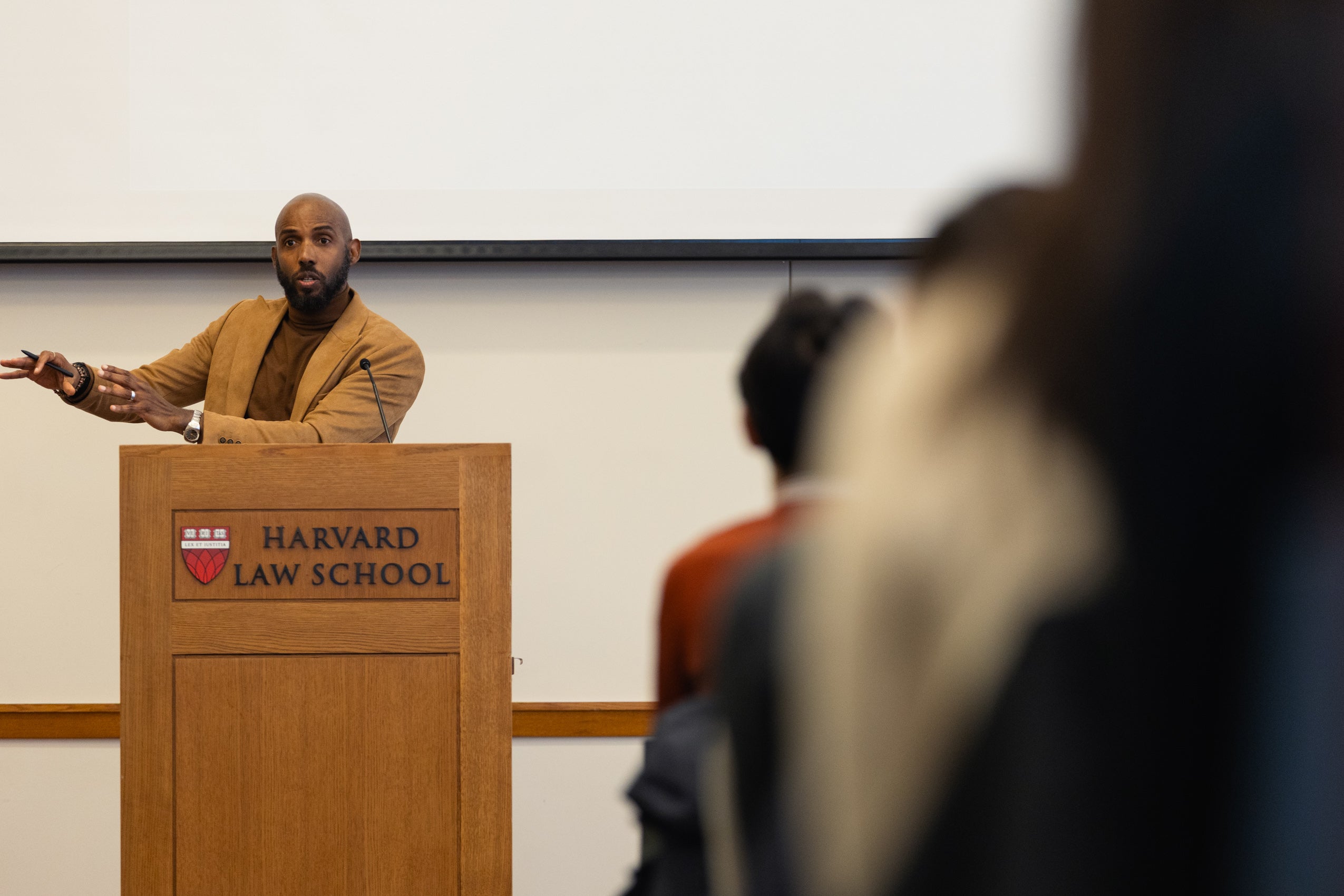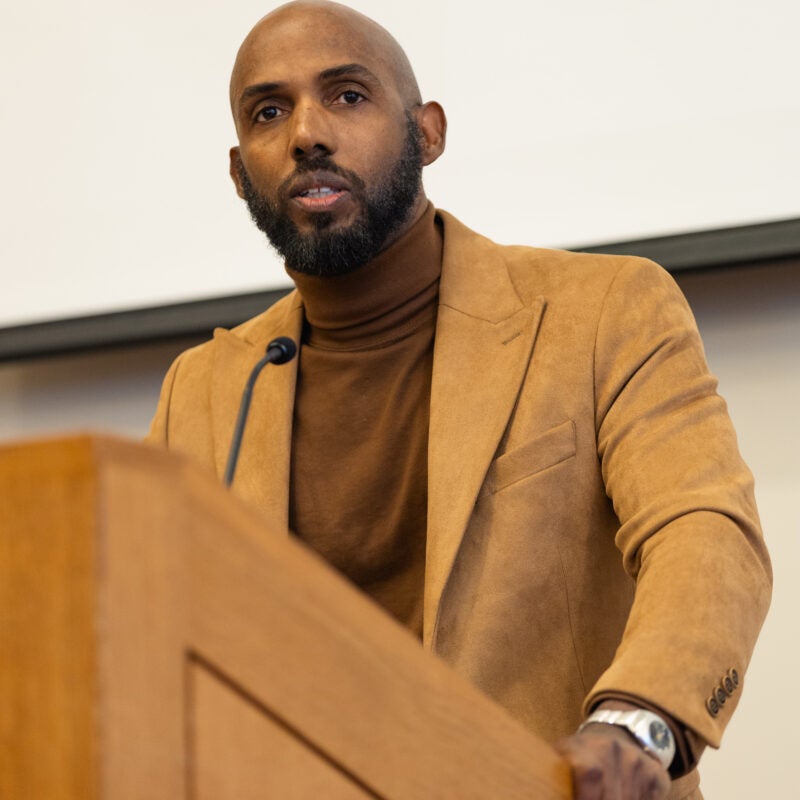Slavery is not just a historical event that happened in America’s past, argued Devon Carbado ’94 at a lecture at Harvard Law School on Tuesday. Instead, slavery was a “structural phenomenon” with an afterlife — one that continues to facilitate racial inequality in the U.S., even in the absence of intentional discrimination or bad actors, he contended.
“The violence of slavery wasn’t just in its chattelism, but also the fact that slavery wired racial inequality and Black subalternity into the social construction of race, into the very intelligibility of race, and into the racial ordering of society,” said Carbado, a professor of law at NYU School of Law.
Carbado’s remarks were delivered as part of Harvard Law’s Belinda Sutton Distinguished Lecture series, which is dedicated to understanding the legacy of slavery and the pursuit of racial justice.
Referencing work by Saidiya Hartman, a scholar of African American cultural history, Carbado began by exploring what was meant by the “afterlife of slavery.” The shameful institution, he contended, was even more brutal than it appeared on the surface — it was also “a form of social engineering that was always already making a racially subordinating future.”
To understand how, Carbado recounted how early American courts helped lend legitimacy to the social construct of race by using — and producing — racial classifications. In these cases, he argued, “Law isn’t just reflecting ideas about race, it’s actually constructing race.”
Once racial categories solidify — and specific characteristics become mapped to different groups — the classification system can be used to justify disparate or even harmful treatment of certain groups, Carbado continued.
“Social meanings of race are not just abstract phenomena. They relate to the very material conditions of race on the ground,” he said, pointing to examples such as slavery (which relied on the social meaning of Black people as inferior) and the internment of Japanese Americans during World War II (which relied on the social meaning of people of Asian descent as disloyal and perpetually foreign).
Ironically, these degradations then act to reinforce the racial hierarchy, Carbado said. For example, the fact that people were enslaved, he explained, communicated the idea that they were inferior.
“Social meanings of race are not just abstract phenomena. They relate to the very material conditions of race on the ground.”

Carbado acknowledged that racial formation is more complex than the account he provided. But he stressed that the critical point is that despite the legal end of slavery after the ratification of the 13th Amendment in 1865, noxious ideas about race continued to be perpetuated in ways that facilitated racial inequality.
Discriminatory laws then piled atop that ignoble legacy — a process he called “racial accumulation.” In Carbado’s view, this is why, even after the Civil Rights Movement overcame formal racial segregation, it was not enough to eliminate the racial inequality that had already accumulated.
“So, what’s law got to do with it?” wondered Carbado. “What does equal protection [in the 14th Amendment to the U.S. Constitution] do against the backdrop of these extant racial inequalities?”
Perhaps not much, he conceded. By requiring courts to determine that the government intended to discriminate before judges could strike down facially neutral actions under the Equal Protection Clause, by treating societal discrimination as too “amorphous” to have constitutional traction, and by rendering disparate impact insufficient to establish equal protection claims, “The Supreme Court has built a wall, brick-by-brick” that is an obstacle to achieving racial justice.
From this vantage point, Carbado argued, the Equal Protection Clause isn’t delivering on its promise of equal protection. It is functioning as an “inequality preserving juridical regime that gets in the way of … addressing racial accumulation.”
For those interested in tackling structural racism, Carbado indicated that the outlook might not be much better in other areas of constitutional law, such as the 4th Amendment, which prohibits unreasonable searches and seizures.
“A particular legal fiction underwrites 4th Amendment law,” he said, referring to the Supreme Court’s decisions about what counts as a seizure under Fourth Amendment law. “Black people have the freedom to leave police encounters, [but] it’s up to them to execute that particular choice.”
Yet, that choice is distorted by historic and ongoing over-policing of Black Americans — something the Court has not confronted in decisions like Illinois v. Wardlow (2000), Carbado argued. The result, he said, is that “If a person tries to exercise their freedom to leave [an encounter], and they’re in a so-called ‘high-crime area,’ and do so by running away, the government is in a good position to argue that their unprovoked flight from a high-crime area gives us reasonable suspicion to formally detain you.”
Carbado concluded by insisting that it is important to learn about how race is constructed and how structural racism perpetuates inequality — even through the law. This, he said — again quoting Hartman — helps us understand that “the relationship between slavery and the present is open and unfinished.”
The Belinda Sutton Distinguished Lecture is named in honor of Belinda Sutton, an enslaved woman born in 1713 and whose unpaid labor contributed to the wealth of Isaac Royall Jr. whose 1781 bequest to Harvard College funded a professorship that helped to establish Harvard Law in 1817. After Royall’s death, Sutton repeatedly petitioned the Massachusetts General Court for a pension from Royall’s estate — a measure of recompense that was eventually granted but ultimately went largely unpaid.
Want to stay up to date with Harvard Law Today? Sign up for our weekly newsletter.
